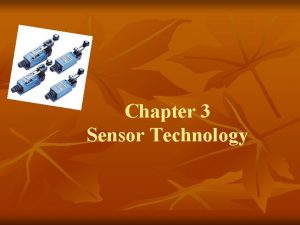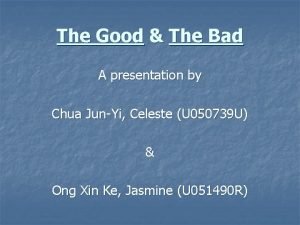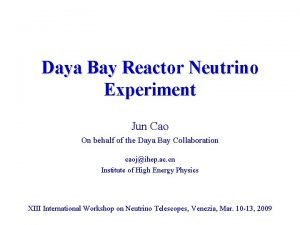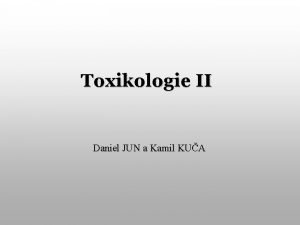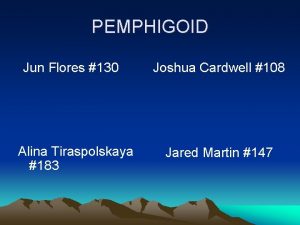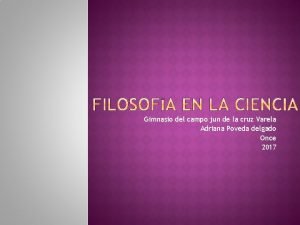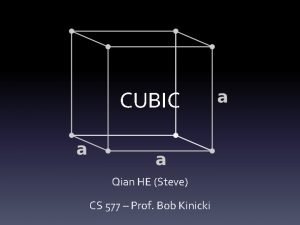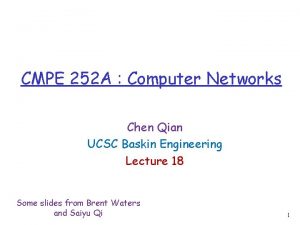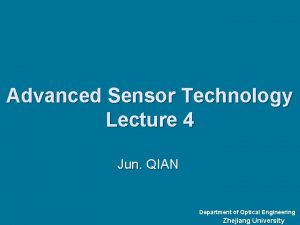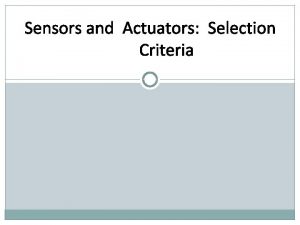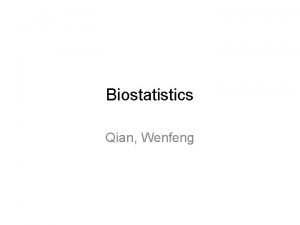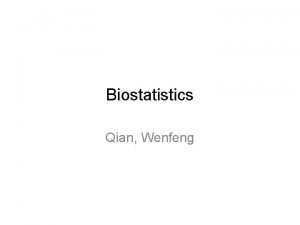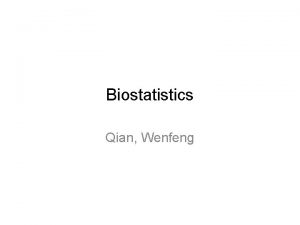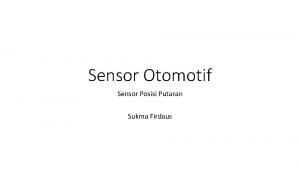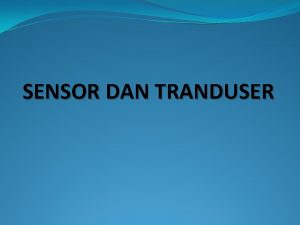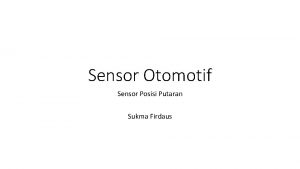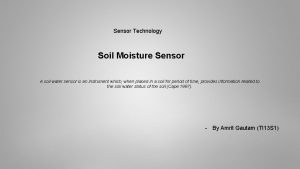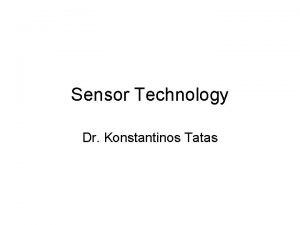Advanced Sensor Technology Lecture 10 Jun QIAN Department



























- Slides: 27

Advanced Sensor Technology Lecture 10 Jun. QIAN Department of Optical Engineering Zhejiang University

Basic Intent: Chemical Sensors n Overview basic concepts for sensing of chemical quantities. This is obviously an extremely broad technical area, so this overview will be incomplete, but is intended to cover the basic issues and some applications. Department of Optical Engineering Zhejiang University

Human Nose n n n The human nasal sensing apparatus contains a remarkably flexible and sensitive detection capability. You are capable of detecting and distinguishing thousands of different smells with almost instantaneous recognition. Odor detection is made very complicated because of the lack of actual uniqueness in the chemical basis of most smells. n There is no "garlic molecule" that is distinct from the "enchilada molecule"; yet you can easily distinguish these smells. Department of Optical Engineering Zhejiang University

Human Nose (cont. ) n n All biological odor detection systems are based on a fairly small number of distinguishable sensors. The smell recognition system is based on pattern-matching of the response of the different chemical sensors in the nose to various odors. Garlic and enchiladas produce a slightly different collective response in the entire set of sensors in your nose, and your brain has stored an extensive collection of these patterns which are used for comparisons. Psychologists have found that these odor patterns can be among the strongest of memories, and smells are often used to aid in the reconstruction of memories. Department of Optical Engineering Zhejiang University

Chemical Sensing System n Chemical sensing system designers need to draw lessons from these biological systems. n An important lesson is that a multi-functional system will probably need to use a small set of distinct sensors and a pattern-matching algorithm to identify odors accurately. A responsive matrix Pattern-Matching algorithm Identify Odors Department of Optical Engineering Zhejiang University

Detectors of Particular Molecules n n If a chemical sensing application requires detection of a particular molecule, several techniques are available. These techniques are based on the unique properties of particular molecules. One set of properties is associated with the vibrational and rotational modes of molecules. n n The exact energies of these modes is generally unique to a particular molecule, and may be used for identification purposes. Most vibrations and rotations are "optically active", meaning that they may be excited by absorption of a photon (FTIR), or may relax by emission of a photon (Raman). These photon absorptions are generally most likely to occur in the infrared, so infrared spectroscopy is a generally useful way to identify molecules. Department of Optical Engineering Zhejiang University

For example, CO detection n CO: A very simple molecule ( 2 balls and a spring), n n n capable of oscillating at a single frequency rotations about 2 axes (both perpendicular to the line connecting the atoms). In quantum mechanics, n a vibration is represented as a single frequency n Quantum mechanics includes "Selection Rules" which strongly favor relaxation a single step of h /2 at a time. This feature shows up in the infrared spectrum as a single absorption. Department of Optical Engineering Zhejiang University

CO detection (cont. ) n n n In the spectrum of the absorption of CO, we see a pair of absorption peaks. This peak splitting is due to the fact that Carbon exists in isotopes which have atomic mass of 12 or 13. The additional mass of the C 13 reduces the vibrational energy simply because it lowers the resonant frequency: 2150 -2180 wave-number Or ~4. 5 m (mid infrared) Department of Optical Engineering Zhejiang University

Rotational energy: NH 3 n n n In addition to vibrations, molecules also can have rotational energy. In the spectrum of NH 3 (ammonia), the rotational spectrum contributes a series of closely-spaced lines centered about the vibrational peaks. These excitations involve the absorption of a photon and the change of both the vibrational and rotational energy. Department of Optical Engineering Zhejiang University

n Method 1: Infrared Spectroscopy Each molecule has a distinct infrared spectrum. n Infrared spectrometers may be used to measure the absorption spectrum of a gas sample, and to look for features which indicate the presence of particular gas constituents. n In this instrument, light from a source passes through a sample-filled chamber, then through a chopper wheel, a filter selector, and is focused onto a detector. n n n The filter selector consists of a pair of filters with very narrow infrared transmission bands. One of the filter's transmission band is centered on the molecular absorption, and the other is centered just off the peak of the absorption band of interest. By alternating between these two filters, a difference signal may be detected only when the molecule of interest is present. This approach can be optimized only for a single molecule at a time, but is very reliable for such single-molecule applications. An example of such an application would be a CO detector for a automotive exhaust inspection/monitoring system. Department of Optical Engineering Zhejiang University

Differentiate molecules by their masses Mass Spectroscopy n Besides the vibrations and rotations, molecules may also be recognized by their mass (or mass spectra. . . ). n Therefore, mass spectrometers are also used to detect and distinguish molecules. A diagram of a magnetic mass spectrometer is shown here Department of Optical Engineering Zhejiang University

Mass Spectrometer n In this device, Molecules Ionized Accelerated in E-field Deflected in Magnetic field By Lorentz force A series of detectors Collect/count particular molecules n One important drawback to such an instrument is that the molecules must travel their entire path without scattering from other molecules. n In air at atmospheric conditions, the average distance between collisions is 1 micron. Since typical mass spectrometers need 10 -100 cm of trajectory, the pressure must be 6 -9 orders of magnitude lower than atmospheric pressure. Therefore, mass spectrometers generally require vacuum pumps. Department of Optical Engineering Zhejiang University

Chromatography: a classic Operation n a sample is added to a pressurized carrier gas, and forced to diffuse through a "column", which is essentially a very long narrow tube. The components of the sample diffuse at different rates through the column, and the detector at the end records a signal-vs. -time trace which contains peaks that may be identified as belonging to a specific sample. Department of Optical Engineering Zhejiang University

Chem Sensors v. s. Biosensors n n The term biosensor refers to any sensor that uses an active biological (or sometimes biologically derived) component in the transduction process. This may be a sensory cell taken from a living organism, and mounted on an electrode. Alternatively, antibodies may be used, which will lock on to the material of interest, and hold it in an appropriate position for sensing. A further option is to use an enzyme that catalyses a reaction that can be detected by suitable means. Department of Optical Engineering Zhejiang University

ISFET sensors n n n ISFETs sense the concentration of a particular ion in a solution. generally based on the enhancement mode MOSFET structure. In the ISFET, the gate metal is replaced with an ion selective membrane the device is immersed in a solution. Ions in the solution interact with the ion selective membrane. When there is a high concentration of positive ions in the solution, a lot of them will accumulate on the gate, widening the channel between the source and drain. +V Problem: low yield for an adhesive membrane Department of Optical Engineering Zhejiang University

Chem. FET / integrated ISFET Department of Optical Engineering Zhejiang University

Fiber optic chemical sensors (FOCS) n n n Operate by transporting light which, either by wavelength or intensity, provides information about analytes in the environment surrounding the sensor. The environment is usually air or water. FOCS can be categorized as intrinsic or extrinsic. n n Extrinsic FOCS simply use an optical fiber as a means to transport light. An example is the laser induced fluorescence (LIF) cone penetrometer. The optical fiber is only a conduit for the laser induced fluorescence to be transported to a detector. intrinsic FOCS use the fiber directly as the detector. A portion of the optical fiber cladding is removed and replaced with a chemically selective layer. The sensor is then placed directly into the media to be analyzed. Interaction of the analyte with the chemically selective layer creates a change in absorbance, reflectance, fluorescence, or light polarization. The optical change is then detected by measuring the change in light characteristic carried by the optical fiber. Department of Optical Engineering Zhejiang University

FOCS (cont. ) Typical Uses n Primarily been developed to measure volatile petroleum constituents such as BTEX and chlorinated VOCs (volatile organic compounds) such as TCE, PCE, and carbon tetrachloride in water, air, or soil gas. n The sensors have been developed to be placed down monitoring wells to provide in situ measurements of VOC concentrations in groundwater. n FOCS typically measure total VOC concentrations and are not capable of distinguishing individual volatile organic chemicals. n With appropriate chemically selective layers, FOCS are capable of measuring SVOCs (semi VOC) as well. Department of Optical Engineering Zhejiang University

FOCS (cont. ) n n n Many of commercial FOCS are coating-based sensors. A portion of the cladding is replaced by a proprietary coating, which selectively and reversibly adsorbs the organic target analytes. The coating adsorbs organics while repelling water. The interaction between the organic target analytes and the coating changes the refractive index of the coating. hydrophobic/organophilic chemical coating. The change in the index decreases the amount of light generated by an LED transmitting to the detector. The resultant loss of light is measured in proportion to the concentration of organics present in the sample. Department of Optical Engineering Zhejiang University

FOCS: Performance n Detection Limits n n Calibration n Typical detection limits are around 1 ppm for VOCs in water. Lower detection limits are possible with pre-concentration of the analyte. Calibration consists of measuring the response of the detector to a calibration standard. Calibration standards should consist of a series of known analyte concentrations in a representative sample matrix. Detector response is plotted against analyte concentration to generate a calibration curve. As with most modern instrumentation, calibration and data acquisition is controlled and recorded with a microprocessor Sample Preparation n FOCS are typically used for in situ measurements precluding sample preparation. Department of Optical Engineering Zhejiang University

FOCS: advantages n Advantages n n n The design of intrinsic FOCS provides in situ and real time monitoring. FOCS are small in size due to small fiber optic diameters. Optical fibers are flexible within limits allowing greater access to difficult locations. Transmission over long distances allow monitoring in deep wells and provide a measure of safety for monitoring of hazardous atmospheres. Multielement analysis is possible using various fibers and a single central unit. Department of Optical Engineering Zhejiang University

FOCS: Limitations n n Some sensors are temperature and time dependent. Because sensor response is based on diffusion, the measured concentration may vary with time that the FOCS is in contact with the target analyte. Therefore, it is critical that equilibrium be achieved before a measurement is taken. Slow response: Most FOCS reach equilibrium in 5 to 10 minutes which is indicated by a steady state signal. The number of reversible reactions, that is adsorption and subsequent desorption, is limited, so probes may have to be regenerated after extended use. Dynamic ranges are usually lower than traditional electrodes which means that either the sample must be diluted or the sensor recalibrated. Department of Optical Engineering Zhejiang University

Chemresistor: a promising sensor Department of Optical Engineering Zhejiang University

Chemresistor (cont. ) Department of Optical Engineering Zhejiang University

Chemresistor (cont. ) n Applications n n Objective n n In-situ real time characterization and monitoring of volatile contaminants Soil, river sampling/monitoring Chem war Develop polymer arrays and investigate microsystems with integrated preconcentrator for enhanced detection capabilities. Major research institute: Sandia NL Department of Optical Engineering Zhejiang University

Target Chemicals n Volatile organic compounds (VOC): n n n aromatic hydrocarbons (e. g. , benzene, toluene, xylenes); chlorinated hydrocarbons (e. g. , TCE, carbon tetrachloride), aliphatic hydrocarbons (e. g. , hexane, octane), alcohols, ketones. Sensitivity: n n Without preconcentration, the chemiresistors can generally detect vapor concentrations that are 1/1000 th the saturated vapor concentration (Henry’s law can be used to convert vapor concentration to equilibrium aqueous concentration). For example, for m-xylene (m-二甲苯), it reliably detected a vapor concentration of ~100 ppm, which corresponds to ~1 ppm in the aqueous phase EPA drinking standard for m-xylene is 10 ppm. Department of Optical Engineering Zhejiang University

Summary n n Our R&D target: An array of fast-response sensors and patternmatching algorithm like human nose Classical Techs: high precision yet big size n n Infrared spectroscopy Mass spectroscopy Chromatography Recent Techs: can be arrayed to certain extent n n n Modified FET: ISFET Fiber Optical Chem Sensor Chemresistor Department of Optical Engineering Zhejiang University
 01:640:244 lecture notes - lecture 15: plat, idah, farad
01:640:244 lecture notes - lecture 15: plat, idah, farad Advanced inorganic chemistry lecture notes
Advanced inorganic chemistry lecture notes Introduction to sensor
Introduction to sensor Jun akizaki – the power of powerpoint
Jun akizaki – the power of powerpoint Yt
Yt Jun feb mar
Jun feb mar Ppt moban
Ppt moban Jun s. liu
Jun s. liu Jun xu md
Jun xu md Jun akizaki
Jun akizaki 55 - 46
55 - 46 Chua jun yi
Chua jun yi Www.brainybetty.com
Www.brainybetty.com Jun cao
Jun cao Daniel jun
Daniel jun Jun flores
Jun flores Informel art
Informel art Ia64 processor
Ia64 processor Gimnasio jun
Gimnasio jun Dash tennis every sunday morning
Dash tennis every sunday morning Dtch lte
Dtch lte Chuang qian ming yue guang li bai
Chuang qian ming yue guang li bai Ni lei
Ni lei Steve qian
Steve qian Qian chen ucsc
Qian chen ucsc Sheri tague purdue
Sheri tague purdue Harvard catalyst biostatistics
Harvard catalyst biostatistics


